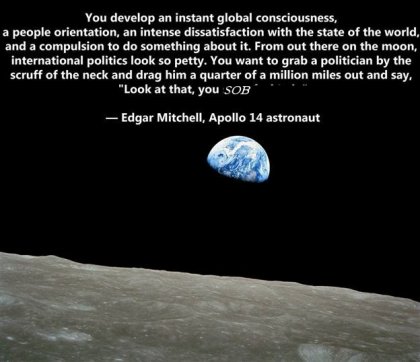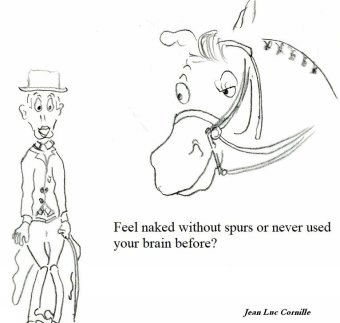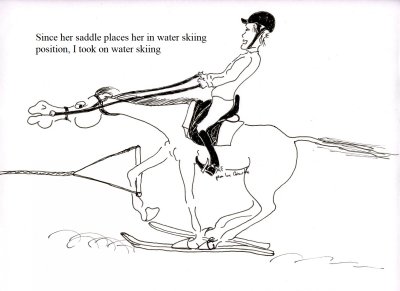Chazot 88
Chazot Thoughts 88

As well, many times, as equines, we have entertained the thought of grabbing a trainer by the scruff of the neck, place his or her nose in front of actual knowledge of our locomotor system and say, look at that; look at the way our body effectively functions, and upgrade your knowledge.
You want your equitation to be simple and you simplify our functional anatomy to the point of painful dysfunction. We are in the twenty first century and some of you continue to believe, and even teach, that your legs contract a muscle that engage our hind legs. The muscle that you touch with your leg, the rectus abdominis, does not engage our hind legs. You touch sensors and these sensors convey the perception of your touch to our brain. Our memory recognizes the meaning of the touch and our brain decides the course of action. However, our main function is to survive and we respond to your stimuli protecting our actual muscle imbalance or other issue. Our response is the best compromise we can figure answering to your insight while protecting our actual body state. You could listen to us and encourage our willingness analyzing our response and providing further insights. You could, through a positive dialogue, guide our brain toward a most efficient body coordination. Instead, if our response does not fit your expectation, you kick us harder.
We have in the area under your legs a very high tactile perception, by kicking us with your heels or even spurs, you overload our perception forcing us into protective reflex contraction. “Using stimuli developed for gauging human tactile sensitivity, we were surprised to find that horse sensitivity on the part of the horse body which would be in contact with the rider’s leg is greater than what has been found for the adult human calf or even the more sensitive human fingertip. Horses can react to pressures that are too light for the human to feel.” (Saslow, 2002) When your legs move, or kick, you create chaos. Our senses are overloaded and we have to protect ourselves. Some of us shut off their perception, others revolt.
perception forcing us into protective reflex contraction. “Using stimuli developed for gauging human tactile sensitivity, we were surprised to find that horse sensitivity on the part of the horse body which would be in contact with the rider’s leg is greater than what has been found for the adult human calf or even the more sensitive human fingertip. Horses can react to pressures that are too light for the human to feel.” (Saslow, 2002) When your legs move, or kick, you create chaos. Our senses are overloaded and we have to protect ourselves. Some of us shut off their perception, others revolt.
In the late nineteen eighties, he removed his spurs. He was not aware at this time of our high tactile perception in the area under his legs; this was discovered almost two decades later. Advanced research studies already suggested at this time that most “forward movement” problem originated form improper management of the forces generated by the hind legs forward through the thoracolumbar spine. Increasing the hind legs activity was a cover up. Efficiency demanded instead to identify and correct the thoracolumbar dysfunction. He removed his spurs knowing that it would be too easy to use them instead of thinking further. He told me that the horses that were in training at this time adapted faster than him to the absence of spurs. He added laughing, I had hard time to keep up with the development of their intelligence. Soon the subtlety, classically attributed to the mastery of spurs, was refined at the level of subtle nuances of the calves contact.
Tom Dorrance and Ray hunt explained that we do what we think you want. We would greatly appreciate if you were expressing “what you want” more clearly. Your aids are like two letters of a puzzle from which we have to construct a complete sentence. Since it is our nature to protect whatever muscle imbalance, morphological flaw, local pain that we experience, we compromise between what we think you want while protecting our body state. Our response is not what you expect and you repeat louder and became aggressive. When you repeat louder, you confirm Einstein’s definition of stupidity, “repeating the same thing and expecting a different result.” Paraphrasing Steve White, when you accuse us of poor behavior, you are covering up your lack of skill. “What we call problem behavior is not the problem. Problem behavior is a symptom of a skill deficit.” (Steve White, Law Enforcement Supervisor, Police K9 Trainer)
Your classical literature emphasizes shifts of your body weight. “Undoubtedly any shift of the rider’s weight is important for balancing the horse for controlled movements.” (Estienne Saurel, 1964. Pratique de l’equitation d’apres les maitres Français. Flammarion Paris) If I had fingers, I would grab you by the scruff of the neck and say read; read, “Movements are generated by dedicated networks of nerve cells that contain the information that is necessary to activate motor neurons in the appropriated sequence and intensity to generate motor patterns. Such networks are referred to as CENTRAL PATTERNS GENERATORs, (CPGs).” (Sten Grillner, The Motor Infrastructure From Ion Channels To Neuronal Network.) Your shifts of weight are creating chaos. Even the ones of you who believe that they master subtle shifts. We can feel minute nuances in muscle tone and how refined your shifts can be, they are gross equitation. Your driving seat disturbs our ability to properly store and reuse elastic energy. 
We have two possible responses to your water skiing position. Take on water skiing or resist. The shifts of your body weight disturb the sophisticated work of our system. The main function of our muscles is ensuring optimum storage and reuse of elastic energy in our tendons, aponeurosis and fascia. This is the essence of efficient locomotion and sound performances. The shifts of your weight disturb us. We are more refined than that. We can feel any nuance in your muscle tone.
We are confused by your wide tree and thick padding saddles which move by their own. You are impressed by our muscle power and you do not understand that we can integrate exquisite sensitivity with superior muscular power. "And, especially, we must respect their integration of exquisite tactile sensitivity with a muscle power that can override any of our commands if we neglect to make our request meaningful, consistent and polite." (C. A. Saslow/ Applied Animal Behaviour Science)
Our fascial tissues are commonly used for a dynamic energy storage, catapult action, during oscillatory movements such as walk, trot or canter. “During these movements, the supporting skeletal muscle contract more isometrically while the loaded fascial elements lengthen and shorten like elastic spring.” (Fukunaga & all, 2002) You think at the level of muscles moving bones and we function at the level of muscle precisely optimizing storage and reuse of elastic energy. “Most of the length change required for the work of locomotion, occurs not in the muscle fibers themselves but by elastic recoil of the associated tendons and muscles aponeurosis.” (The role of the extrinsic thoracic limbmuscles in equine locomotion. R. C. Payne, P. Veenman and A. M. Wilson. J. Anat. (2005) 206, pp 193-404).
In politique, “No one is going to give you the education that you need to overthrow them.” You approached us with the same pitiful psychology. You regard us as slaves to be controlled and submitted. You have been unable to take conscience of our willingness because your human nature does not allow you to understand that we are willing to work with you just for the sake of willingly work with you. In your culture you have to dominate and you regard our power as a treat that needs to be dominated. You have ruined your own riding life as well as the life of many of us. All along, we have been willing, but your primitive riding techniques and psychology never entertained the though that helping us to think further would not challenge your authority, but instead further our partnership.
“When a flower doesn’t bloom, you fix the environment in which it grows, not the flower.” (Alexander den Heijer) Your riding techniques as well as your therapies try to fix the flower. You have a capacity of analysis that we can use. We protect our problem; we don’t have the mental capacity of analyzing the problem and finding the root cause. You have such capacity and we have hoped all this time that our partnership with you will allow us to express our difficulties without fear of punishment and count on your knowledge and analytic capability to identify the source and guide our brain toward the appropriated coordination. This is what he does’ this is what the science of motion is about and we are happy to see the wave swelling and rolling. Chazot


 twitter
twitter facebook
facebook google
google pinterest
pinterest linkedin
linkedin